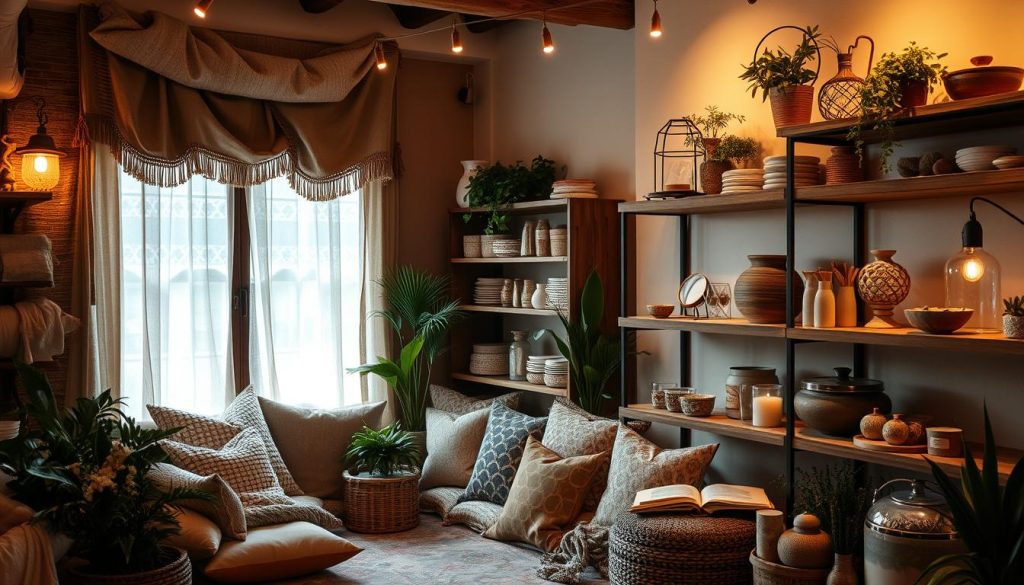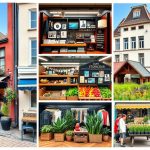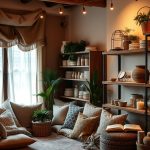Making displays inviting and the atmosphere captivating is key to improving visitor experiences. This is true in retail spaces, exhibitions, and even in our homes. Well-designed displays do more than look good; they grab attention and leave a lasting impact. We’ll look at important display techniques that make the atmosphere better. We’ll focus on design, sensory elements, and how to put these into practice.
Key Takeaways
- Inviting displays are crucial for engaging visitor attention.
- A captivating atmosphere can enhance overall experiences.
- Utilising effective display techniques can create memorable impressions.
- Design principles play a pivotal role in atmosphere enhancement.
- Incorporating sensory elements enriches the visitor experience.
- Practical tips can make the crafting of displays more effective.
Understanding the Importance of Inviting Displays
Displays are key in many settings. They make the first impression that sticks with visitors. This sets the tone for a memorable visit.
First impressions shape how people see a place. They decide if they want to look around more. In shops, good displays make people more likely to buy things. For instance, stores with well-designed displays keep customers coming back.
Displays do more than just look good. They create a deep emotional connection with people. Things like colour and how things are arranged make visitors feel part of the experience. When people feel a bond with a display, they spend more time looking at products. This can lead to more sales.
Key Elements of a Captivating Atmosphere
A captivating atmosphere is made up of many ambience elements. These include lighting, layout, colour schemes, and sensory design. Each one plays a big part in how we feel and interact in a space.
Lighting is very important as it sets the mood and affects our feelings. The right lighting can turn a dull area into a welcoming space. Natural light brings in a fresh and lively feel, linking us to the outdoors.
The way furniture and decor are arranged is key too. A well-planned layout helps people move around easily and discover new things. It makes them want to interact with the space more. Colour schemes also add to the look, making everything work together well.
Texture and scent are the last big factors in sensory design. They make the experience richer, engaging more senses. A great atmosphere makes people want to stay, explore, and feel a strong connection to the place.
| Ambience Element | Impact on User Experience |
|---|---|
| Lighting | Sets mood, influences emotions, enhances visibility |
| Layout | Encourages exploration, fosters social interaction, guides movement |
| Colour Scheme | Creates visual harmony, evokes feelings, attracts attention |
| Sensory Design | Engages multiple senses, promotes immersion, establishes emotional connections |
Creating an Inviting Display and Atmosphere
Creating an inviting atmosphere starts with knowing the space’s purpose. It’s key to understand the message you want to share and who you’re sharing it with. This helps make a design that connects with people. A clear purpose also makes the most of the space, making it both beautiful and useful.
Defining Your Space’s Purpose
Think about the role of the space before setting up your display. Is it a shop, a gallery, or a place for events? Knowing what you want to achieve will guide your choices on how to arrange things. For instance, a boutique might want to feel luxurious, while a community space should be welcoming and easy to get into. Making your display match these goals makes sure everyone finds it engaging.
Choosing the Right Colour Palette
Colour psychology is a big help in making displays inviting. Different colours can make people feel different things. Warm colours like reds and oranges make people feel cozy and lively, perfect for social areas. On the other hand, cool colours like blues and greens can make people feel calm and peaceful. Picking colours that fit the space’s purpose can make it feel just right and guide how people move through it.
Using a well-thought-out colour scheme and design can turn a dull space into a lively, welcoming place. Here’s a table showing how different colours can affect feelings:
| Colour | Emotion Evoked | Ideal Uses |
|---|---|---|
| Red | Excitement, Energy | Restaurants, Retail |
| Blue | Calmness, Trust | Offices, Healthcare |
| Yellow | Happiness, Warmth | Children’s spaces, Creative studios |
| Green | Balance, Growth | Parks, Wellness centres |
| Purple | Luxury, Creativity | Spas, Upscale boutiques |
Utilising Natural Light for Effect
Natural light is key to making any space feel better. It softens colours and highlights textures, making things look more appealing. This warm light makes spaces feel welcoming, which can make visitors more engaged and comfortable.
To get the most from natural light, using smart lighting techniques is important. Here are some top tips:
- Window Placement: Put windows where sunlight can shine in during the day. This makes the area brighter and adds a view, blending indoors with outdoors.
- Reflective Surfaces: Use mirrors, glass, or shiny finishes. They reflect light, making the room brighter and feeling more open.
- Outdoor Elements: Add plants and greenery inside. This not only looks good but also matches the natural light, creating a peaceful feel.
Real examples show how well these methods work. Shops with lots of natural light draw in more customers and make shopping more fun. Brands that focus on soft lighting see more sales. This shows how important good lighting is for attracting customers.
| Technique | Benefits | Examples |
|---|---|---|
| Window Placement | Improved brightness, connection to outside | Showrooms with large glass facades |
| Reflective Surfaces | Increased light diffusion, spacious feel | Modern retail stores with mirrored displays |
| Outdoor Elements | Enhanced biophilic design, emotional well-being | Restaurants with indoor gardens |
Incorporating Textures for a Warm Feel
Creating a warm and inviting atmosphere is all about the right textures. Using different textures adds warmth and visual interest. Choosing materials like fabric, wood, and metal makes any space come alive.
Choosing Complementary Materials
The right materials set the mood for a display. Fabrics bring softness, while wood adds an organic feel. Metal gives a modern look. Each material adds its own touch of warmth.
- Soft, plush textiles for seating and drapery
- Natural woods for furniture and accents
- Sleek metals for light fixtures and decorative details
Layering Textures to Create Depth
Layering textures adds depth and guides visitors through a space. For example, a knitted throw with a smooth leather sofa creates contrast. To layer effectively, try:
- Incorporating rugs of various textures and sizes
- Mixing cushions with differing fabrics and patterns
- Using decorative objects that add a tactile element
Textural design is key to making a space inviting. By choosing and layering materials thoughtfully, designers can make displays warm and engaging. This ensures visitors feel welcomed and connected.
The Role of Furniture in Display and Atmosphere
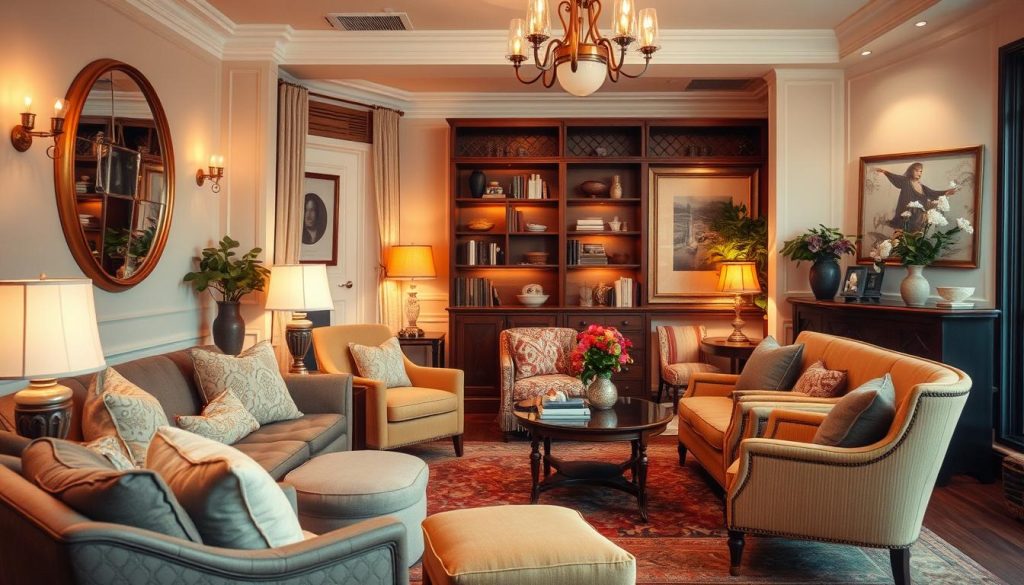
Furniture is key in shaping the look and feel of a space. Choosing furniture that fits the theme makes the space look better. Arranging furniture well can improve how people move around and enjoy the space. Let’s look at why picking the right furniture and arranging it well is important.
Selecting Appropriate Furniture Styles
Various furniture styles can create different moods. Think about these points when picking furniture:
- Consistency: Make sure furniture matches the space’s theme and purpose.
- Comfort: Pick furniture that looks good and feels comfortable.
- Durability: Choose furniture made from quality materials that lasts.
Arranging Furniture for Optimal Flow
How furniture is arranged affects a space’s look and use. Here are tips for arranging furniture well:
- Define Pathways: Make sure there are clear paths for moving around to avoid crowding.
- Create Zones: Use furniture to mark areas for different activities, making the space more useful.
- Balance Aesthetics and Functionality: Strive for a design that looks good and serves practical needs.
Additions That Enhance Ambience
Adding different things to a space can make it feel better. Things like plants, art, and special furniture make it welcoming. Adding plants not only makes it look good but also makes people feel calm.
When picking decor, think about what the space is for. Art can make people feel things and think deeply. Choosing art that speaks to the visitors makes the place feel more personal and interesting.
Decor that matches a theme can make a big difference. Changing the decor for different events or seasons keeps things fresh. Adding autumn colours or summer flowers makes the space more appealing.
Creating Focal Points in Displays
In any display, it’s key to have focal points to guide visitors and make the experience better. A good display strategy uses impactful decor to make clear visual hierarchies. This helps engage and inform people. We’ll look at how to pick and place focal points well, using examples from galleries and shops.
Using Art and Decor Effectively
Art and decor are crucial for making focal points in a display. By choosing pieces that fit the theme, designers can tell a story and connect with people. Focal points should be noticeable but fit with the rest to keep things looking good. Here are tips for creating impactful decor:
- Pick eye-catching art that matches the display’s theme. Modern art or pieces by local artists can grab attention.
- Use different sizes and shapes. Big pieces and small accents create a lively visual order.
- Colour can draw people in. Bright colours energise, while soft colours calm.
- Think about how you arrange things. Pieces at different heights catch the eye from all sides.
- Lighting is key. It makes art and decor stand out and adds depth to the display.
Knowing how to use focal points turns any display into something exciting that makes people want to look closer.
The Influence of Scent on Atmosphere

Scent marketing is key to shaping the feel of any space. It’s not just an extra touch; it can bring back strong feelings and memories. This can change how people act and feel in a place, making it more welcoming.
Businesses in many fields now see scent as a big part of making an experience. For example, big stores like Starbucks use special scents to make a warm welcome. The smell of fresh coffee makes customers feel closer to the brand, making them stay longer.
A good scent can also make people feel better. Studies show that nice smells can make you happier, keep you around longer, and even boost sales. Hotels use their own special smells to make guests feel at home and connected to the brand.
Learning about scent marketing can open up new ways to connect with customers. By choosing the right smells, businesses can change how people feel and what they remember. Adding scent to the mix can really make a brand stand out.
| Business Type | Fragrance Used | Psychological Effect |
|---|---|---|
| Cafés | Freshly brewed coffee | Creates a sense of comfort |
| Retail Stores | Citrus notes | Increases alertness |
| Hotels | Lavender and vanilla | Promotes relaxation |
| Spas | Eucalyptus | Encourages tranquillity |
Soundscapes: The Unsung Hero of Atmosphere
Soundscapes are key to creating an immersive audio atmosphere often missed. They greatly improve the visitor experience with well-designed sound. By using ambient sounds, places can make a warm welcome that lifts mood and boosts engagement.
Sound design techniques are vital for a good audio atmosphere. Background music can set the mood in different areas. Adding natural sounds like birdsong or flowing water can make people feel calm and connected to nature. These sounds help visitors want to explore and engage with their surroundings more.
Creating soundscapes needs careful planning. Here’s a look at how different sounds affect the environment:
| Sound Element | Effect on Atmosphere | Impact on Visitor Engagement |
|---|---|---|
| Background Music | Sets the emotional tone and ambiance | Encourages longer visits and interaction |
| Natural Sounds | Creates a calming, immersive experience | Enhances emotional connection and relaxation |
| Sound Effects | Adds depth and interest to exhibits | Stimulates curiosity and exploration |
When soundscapes are well thought out, visitors connect more with their surroundings. By focusing on sound details, a simple display can turn into a captivating experience. This keeps guests interested and around for longer.
Seasons and Their Impact on Display Choices
Seasonal displays are key to making retail and events engaging. They help businesses connect with customers and boost sales. By matching displays with the season, shops can draw in more customers.
Being able to change designs with the seasons is crucial. Shops and events need to keep their looks fresh and relevant. Here are some tips for making seasonal changes:
- Spring: Use pastel colours and floral elements to evoke feelings of renewal.
- Summer: Incorporate vibrant hues and outdoor-themed items, such as beach and travel motifs.
- Autumn: Embrace warm tones like oranges and browns, with decorations that reflect harvest themes.
- Winter: Highlight festive colours and decorations, drawing on themes like coziness and celebration.
Matching displays with the season helps businesses connect with customers on a deeper level. This approach not only boosts engagement but also encourages customers to return, helping sales grow.
| Season | Suggested Elements | Customer Engagement Techniques |
|---|---|---|
| Spring | Floral arrangements, bright colours | Workshops on planting, spring sales events |
| Summer | Outdoor furniture, travel-themed décor | Social media contests for summer fun |
| Autumn | Harvest displays, warm colour palettes | Seasonal recipes, themed shopping nights |
| Winter | Festive lights, cosy textures | Holiday events, discounts on winter goods |
Making Use of Technology in Atmospheres
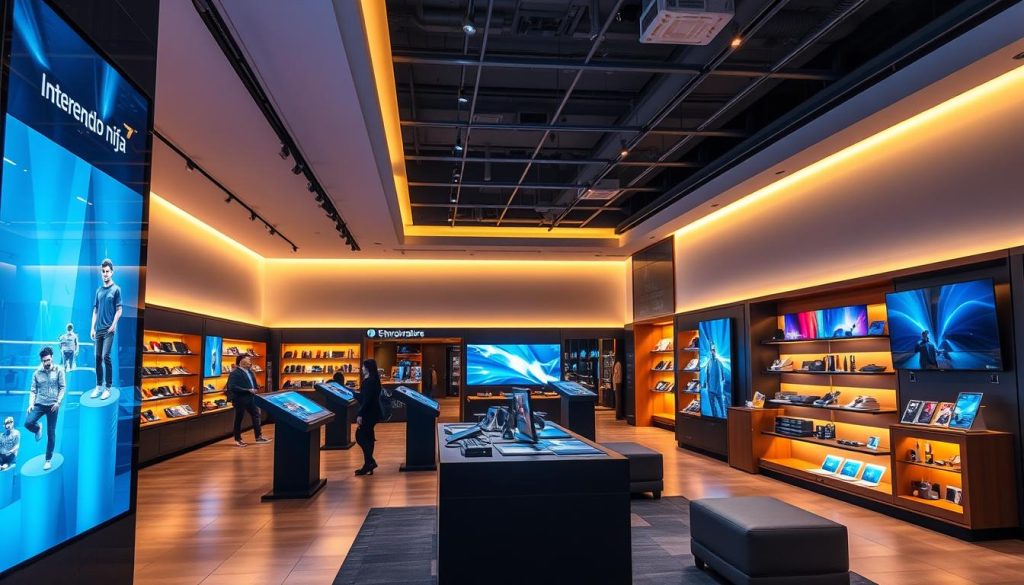
Using the latest technology can really lift the feel of any space. It’s key to making a space vibrant and flexible. With smart lighting and digital displays, spaces can change easily and look better.
Smart Lighting Solutions
Smart lighting lets you change the brightness and colour to fit the time or mood you want. These systems make a space welcoming and useful. They often have:
- Automated adjustments that match natural light changes.
- Customisable settings for different events or seasons.
- Energy-efficient options that are good for the planet.
Digital Displays and Their Benefits
Digital innovation has changed how we show information and art. With dynamic content, displays can change in real-time based on what visitors do. This helps in many ways:
| Features | Traditional Displays | Digital Displays |
|---|---|---|
| Content Change | Static | Dynamic |
| Interactivity | None | High |
| Engagement | Limited | Enhanced |
| Update Frequency | Infrequent | Real-time |
Using technology in displays makes things look better and more engaging. It also makes the environment more adaptable. Smart solutions create a modern feel that appeals to today’s audience.
Feedback and Adaptation of Displays
Gathering visitor feedback is key to making displays better. It gives insights into what visitors like and helps improve the atmosphere. By understanding how visitors see things, we can make displays more engaging and relevant.
Understanding Visitor Perception
To adapt displays well, we need to know how visitors see the space. Talking to them, doing surveys, and watching how they act can tell us what they prefer. This info helps shape the look and feel of the displays. The aim is to make the experience smooth and connect with the audience.
Iterating Based on Feedback
Using feedback to improve displays leads to better results. It’s a cycle of checking and tweaking to meet visitor expectations. Case studies show how changing designs based on feedback boosts visitor satisfaction. Using tables or charts can show trends in feedback, pointing out what needs work.
| Feedback Method | Insights Gained | Impact on Display Adaptation |
|---|---|---|
| Surveys | Visitor preferences and suggestions | Specifically tailored improvements based on insights |
| Direct Engagement | Real-time reactions and comments | Immediate adjustments and creative brainstorming |
| Observation | Visitor behaviours and interactions | Informed decisions about layout and display elements |
Eco-Friendly Practices in Displays
Creating displays that focus on being eco-friendly makes them look better and helps the planet. Using materials that are good for the earth cuts down on carbon emissions. It also makes our planet healthier.
Brands like IKEA and Patagonia show how to make displays that are good for the earth. They use materials like reclaimed wood and organic fabrics. This appeals to people who want to buy from brands that care about the planet.
- Incorporate local, sustainable materials to support your community.
- Choose suppliers who engage in green practices, ensuring a responsible supply chain.
- Create displays that are easily reusable or recyclable, reducing waste.
- Consider energy-efficient lighting solutions to enhance your display while conserving energy.
When looking for eco-friendly products, do your homework. Pick materials that have green certifications like FSC or GOTS. Working with local artisans also helps reduce environmental harm and supports unique skills.
| Brand | Sustainable Material Used | Impact on Environmental Footprint |
|---|---|---|
| IKEA | Reclaimed wood | Reduces deforestation and waste |
| Patagonia | Organic cotton | Minimises pesticide use and water consumption |
| H&M | Recycled polyester | Decreases reliance on virgin resources |
Using eco-friendly practices in displays boosts a brand’s image and meets customer demands for green choices. This leads to a more sustainable future.
Showcasing Local Products and Artisans
Adding local artisans to your shop makes it more welcoming and builds community spirit. It’s great to show off handcrafted items and artwork made by people in your area. This approach makes shopping more special and memorable for customers.
It also shows you care about the local economy and builds trust with the community. By regularly changing the artisans’ goods, you keep things fresh and exciting. This lets customers always find something new and interesting.
Sharing the stories of these artisans adds a personal touch. It makes customers feel closer to the products and the people who made them. This makes the whole shopping experience more appealing.
In the UK, many businesses have seen great success with this idea. Artisan markets and local shops often display items from nearby makers. This draws in more customers and gets them involved. The Custard Factory in Birmingham is a great example of how supporting local artisans can boost community spirit and improve the look and feel of a place.
By focusing on local products and their stories, your shop can become a creative and welcoming spot. It encourages a strong local economy and brings people together.

